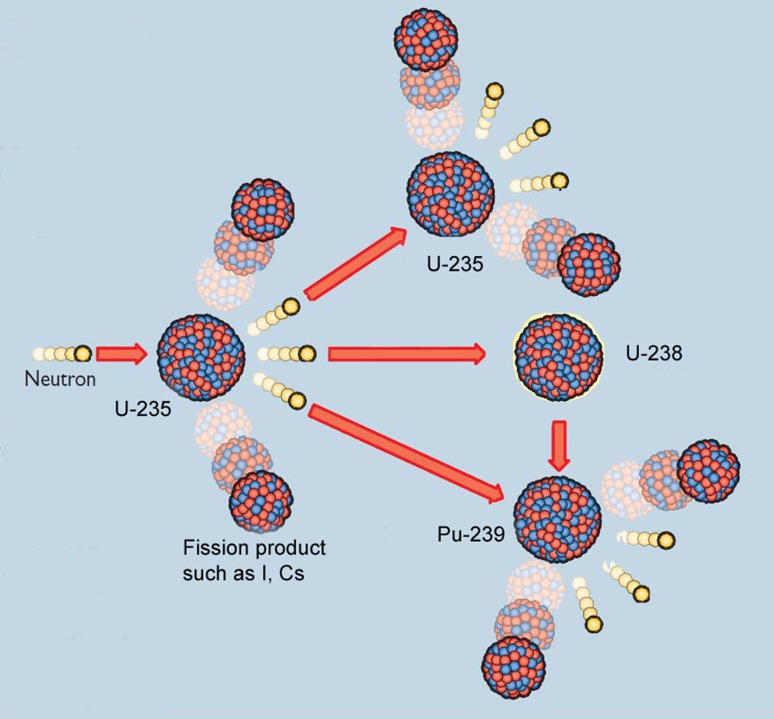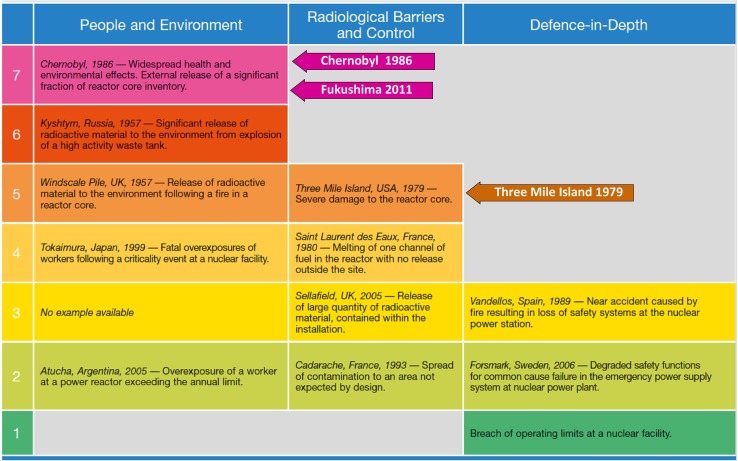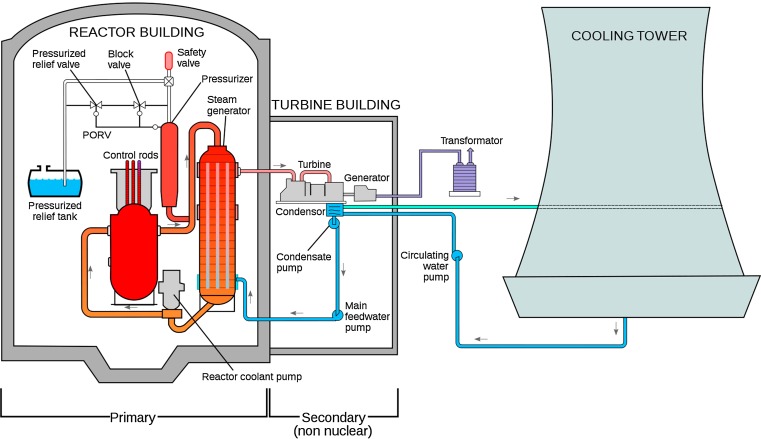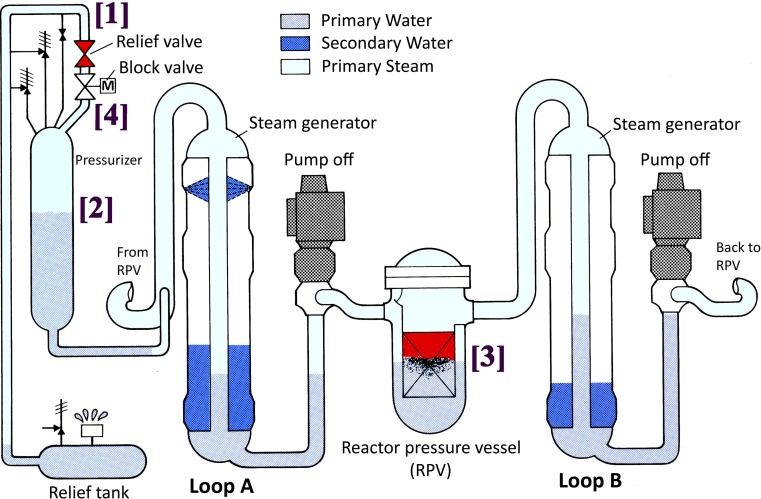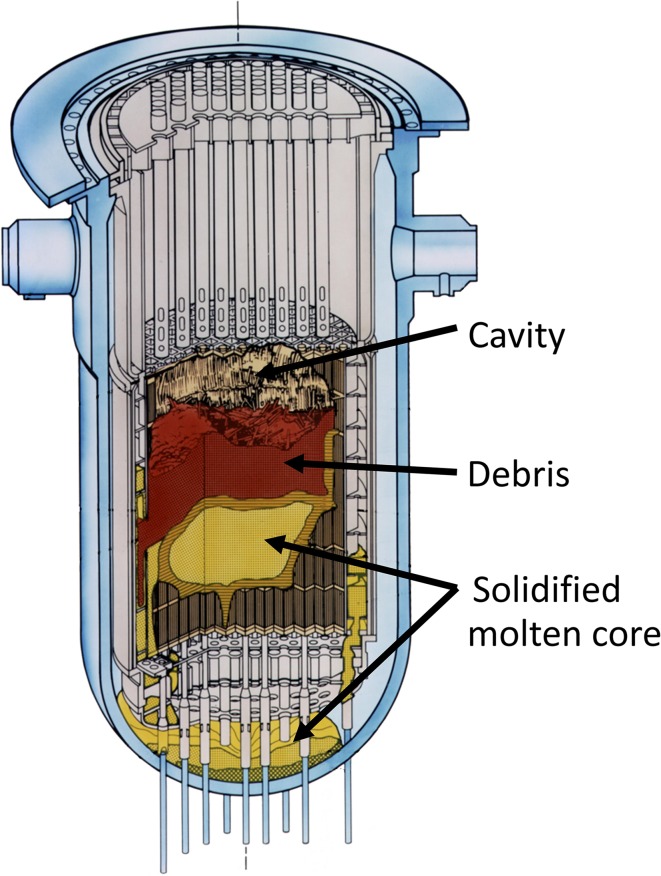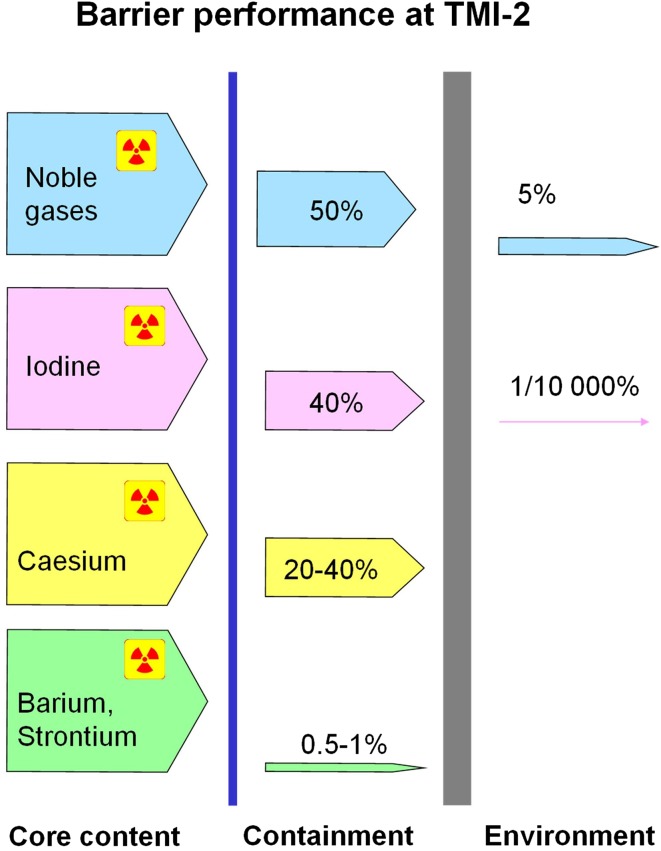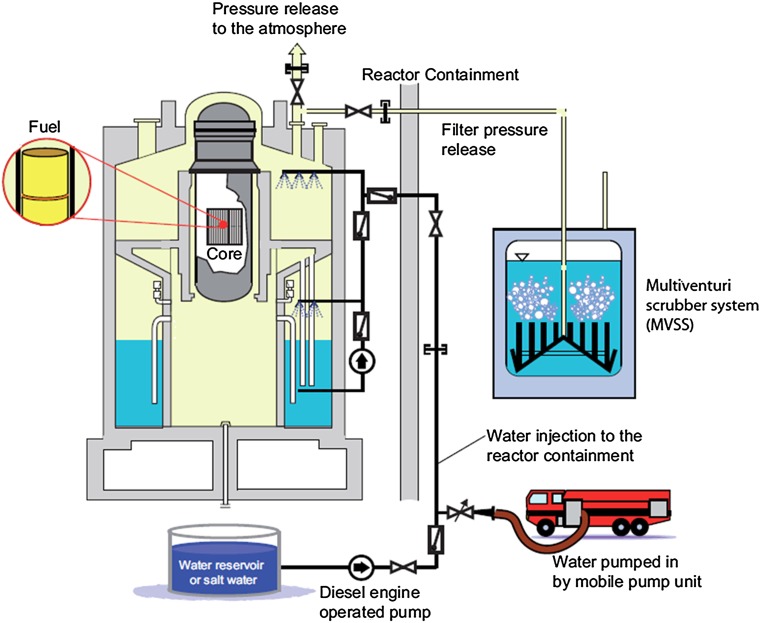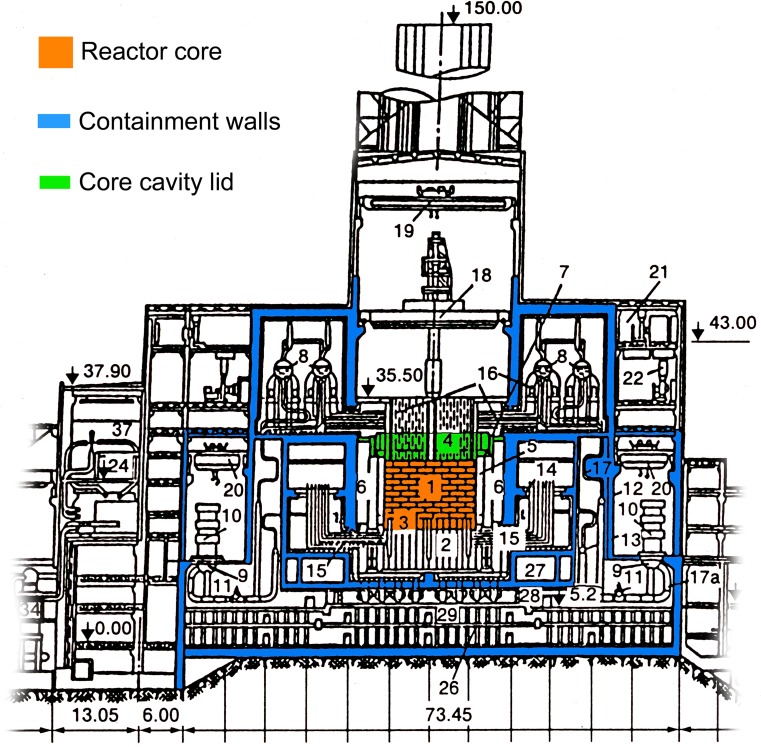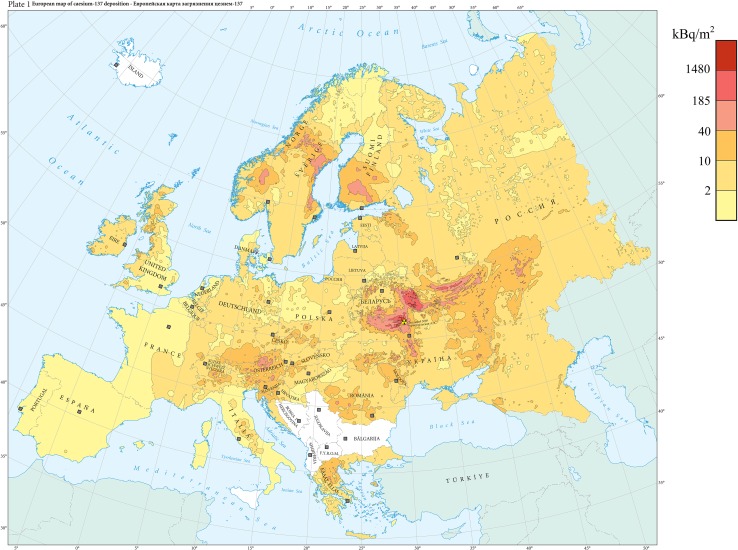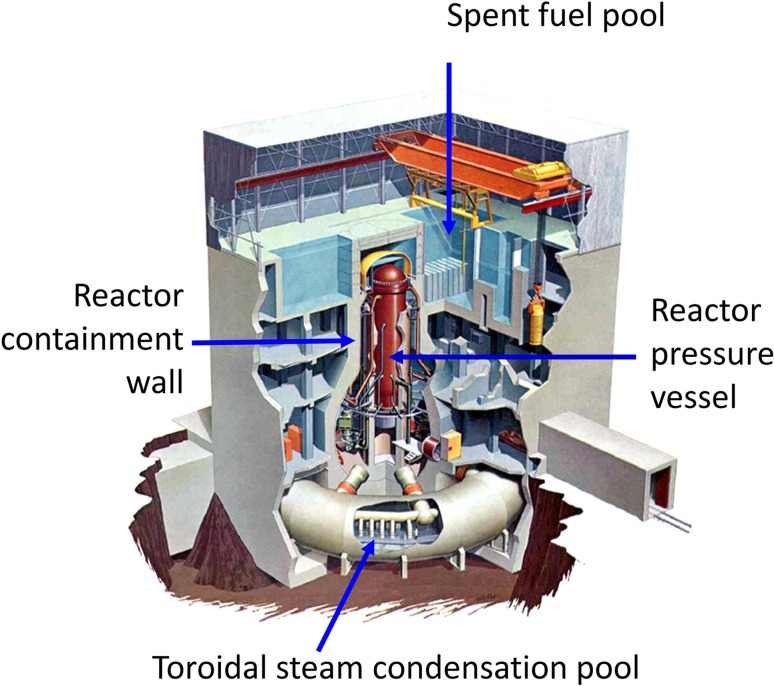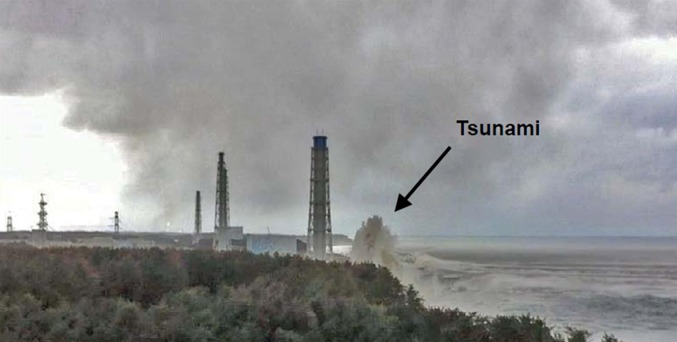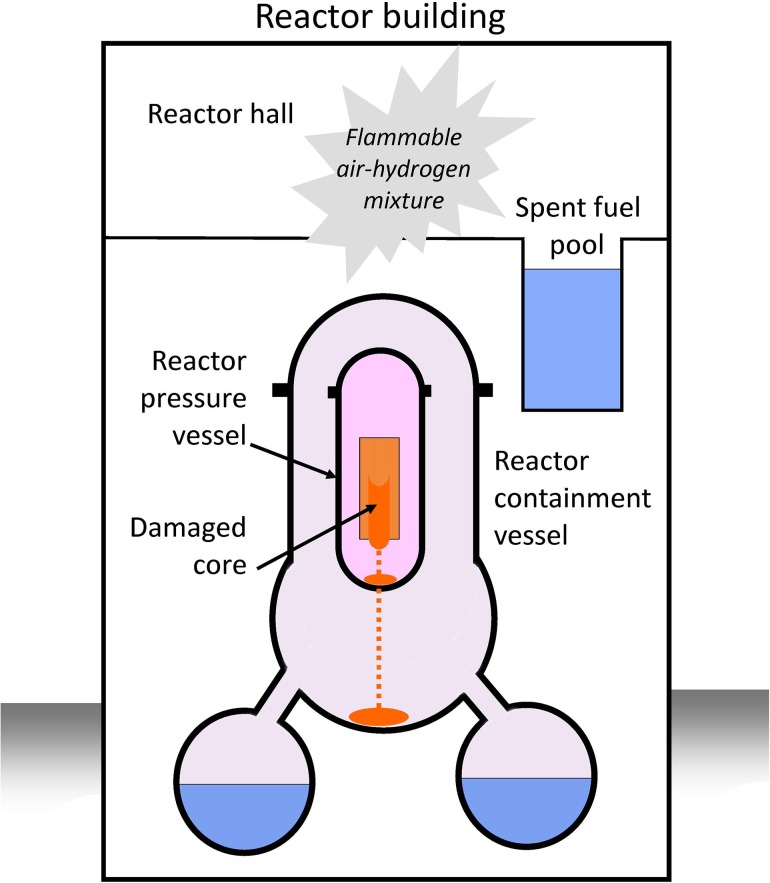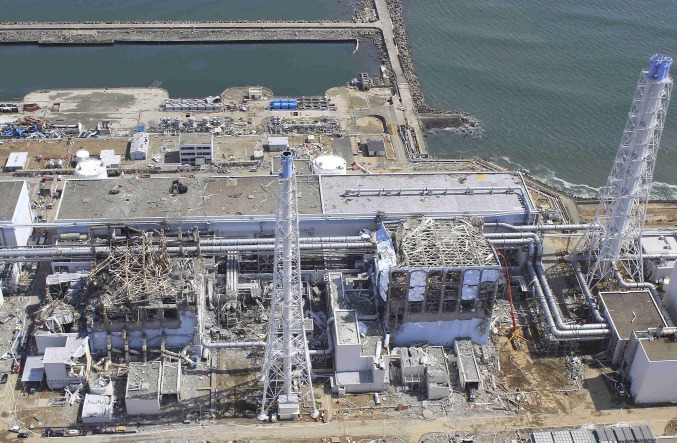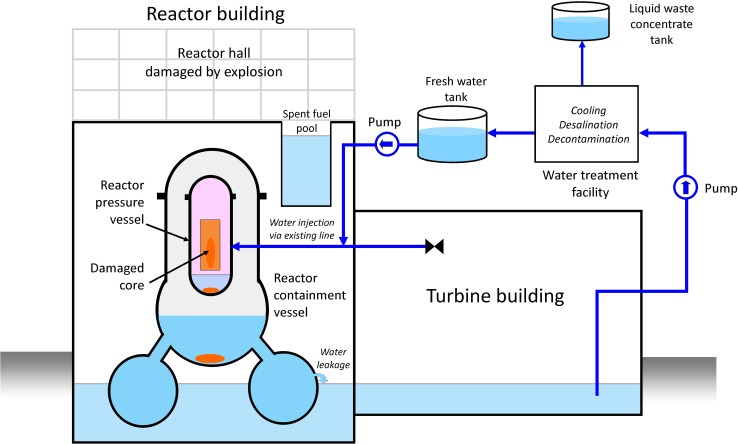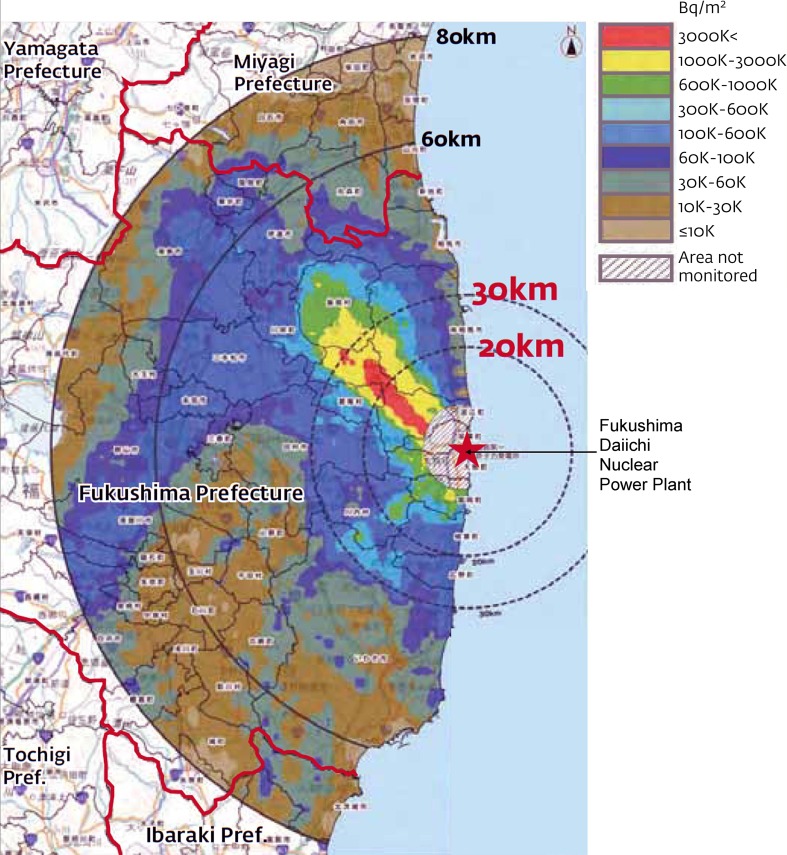Abstract
The root causes and impacts of three severe accidents at large civilian nuclear power plants are reviewed: the Three Mile Island accident in 1979, the Chernobyl accident in 1986, and the Fukushima Daiichi accident in 2011. Impacts include health effects, evacuation of contaminated areas as well as cost estimates and impacts on energy policies and nuclear safety work in various countries. It is concluded that essential objectives for reactor safety work must be: (1) to prevent accidents from developing into severe core damage, even if they are initiated by very unlikely natural or man-made events, and, recognizing that accidents with severe core damage may nevertheless occur; (2) to prevent large-scale and long-lived ground contamination by limiting releases of radioactive nuclides such as cesium to less than about 100 TBq. To achieve these objectives the importance of maintaining high global standards of safety management and safety culture cannot be emphasized enough. All three severe accidents discussed in this paper had their root causes in system deficiencies indicative of poor safety management and poor safety culture in both the nuclear industry and government authorities.
Keywords: Nuclear power, Nuclear accidents, Socio-economic impacts, Reactor safety goals
Introduction
Key Hazards in Operation of Nuclear Power Plants
The fission process (Fig. 1) which is the power source in nuclear power production is also the origin of the key hazards in the operation of nuclear power plants. The fission of uranium and plutonium nuclei generates a number of radioactive fission products that could escape to the environment and be widely dispersed if a severe accident occurs.
Fig. 1.
The fission process: A uranium nucleus is split in two parts (fission products) when hit by a neutron. New neutrons are also produced so that a chain reaction can be maintained. Energy is released in the process and ends up as heat in the reactor core. Drawing: SKI/sgb
In normal operation and in a number of events and disturbances taken into account in the design of the nuclear power plant, these radionuclides are prevented from escaping to the environment by several physical barriers. These are typically the tubes of zirconium alloy into which the uranium oxide fuel pellets are sealed to make up the reactor core, the steel pressure boundary of the reactor core coolant system, and the reactor containment, typically a solid concrete structure enclosing the main parts of the reactor. Various safety systems, such as emergency cooling systems, are in place to protect the integrity of these barriers also in case of very unlikely events. Thus, the prevention of radioactive releases to the environment is based on what is known as the principle of defense-in-depth.
However, as experience shows, it cannot be totally excluded that events occur that challenge the integrity of the barriers beyond what they are designed to cope with (their design basis), resulting in failure of one or more of the barriers. If all of them fail there is a potential for substantial release and dispersal of radioactive material to the environment. The principal mechanisms that can cause barrier failure are loss of reactivity control (control of the fission process) and loss of cooling of the reactor core.
Loss of Reactivity Control
As a reactor core contains fissile material sufficient for a year or more of full power operation, there is a potential for abnormal increases in power production (power excursions) with energy releases and associated forces far beyond the design basis of the barriers, leading to barrier failure. To prevent such power excursions, reactivity control systems with extremely high reliability are essential. Moreover, most power reactor cores are designed to be inherently stable, typically with a negative power coefficient of reactivity, meaning that inherent physical mechanisms in the core work to reduce the fission rate if the power starts to increase.
Loss of Core Cooling
Even if the fission process is stopped, heat continues to be produced in a reactor core, due to the energy released in the radioactive decay of the fission products. In a typical water-cooled power-producing reactor with a 1000 MW electrical output, the core generates a thermal power of about 3000 MW during normal operation. In the first few seconds after shutting down the fission chain reactions in a power reactor core, the residual heat generated by fission product decay corresponds to around 7 % of full power or around 200 MW in a 3000 MW core. After 1 h, this residual decay heat corresponds to about 2 % of full power or around 60 MW and after 36 h to around 15 MW.
If supply of cooling water to the core is lost soon after the fission process is stopped, this residual power will cause the core to overheat, disintegrate and eventually start to melt, typically on a time scale of a few hours at most. Even if the supply of cooling water is lost, the zirconium-clad fuel in the core will typically be surrounded by water vapor. The heat-up and meltdown process will be accelerated once the zirconium fuel cladding reaches about 1200 °C, when a rapid exothermal reaction will start:
 |
Thus, besides heat, large amounts of hydrogen are generated with a potential for destructive explosions or even detonations if leaked to parts of the reactor and its surrounding buildings that have an oxygen-containing atmosphere.
Fission Products of Main Concern with Regard to Socio-economic Impact
The mechanisms described above with a potential to cause severe core damage can also provide energy for dispersal of fission products from the damaged core to the environment. This can happen if the remaining barriers against radioactive releases also fail. Of special concern is the release of fission products that can cause large-scale land contamination with substantial medium- to long-term socio-economic impact. Such fission products include isotopes of iodine and cesium. These are vaporized in the temperature range typically reached in an overheated core and then form aerosols of various chemical compositions. Radioactive noble gases are more of a short-term concern as they can cause high doses to people on site and in the vicinity of the plant. However, they are typically rapidly dispersed in the atmosphere with little significant long-term socio-economic impact. Releases of noble gases are in fact rather comparable to the releases of poisonous gases, such as chlorine, that may occur in conventional industry accidents.
A typical radioactivity content of a contemporary 3000 MW reactor core with regard to some radionuclides of main concern in case of a severe reactor accident is listed in Table 1.
Table 1.
Typical activity content of a contemporary 3000 MW boiling water reactor (BWR) core (limited to some isotopes of main concern)
| Isotope | Activity content in TBq (1012 Bq) | Half-life |
|---|---|---|
| Xenon-133 (Xe-133) | 6 000 000 | 5.28 days |
| Iodine-131 (I-131) | 2 900 000 | 8.04 days |
| Iodine-133 (I-133) | 6 100 000 | 0.88 days |
| Cesium-134 (Cs-134) | 310 000 | 2.06 years |
| Cesium-137 (Cs-137) | 320 000 | 30.1 years |
| Strontium-90 (Sr-90) | 250 000 | 28.5 years |
Sandia National Laboratories (2012)
Early Theoretical Assessments of Severe Accident Risks
The potential consequences of severe reactor accidents with a release of a substantial fraction of core content of fission products were identified and assessed in a number of theoretical studies, starting already in the 1950s (U.S. Atomic Energy Commission 1957; Rasmussen 1975). Much of the focus in these early studies was on potential health effects in terms of early and late fatalities due to radiation exposure of the population living at various distances from the nuclear power plant, but the models used also estimated the ground contamination caused by various types of accidents.
In Sweden, data from the study from 1957 cited above were used to evaluate a proposal to site a large nuclear reactor for combined district heating and electricity production inside urban Stockholm (the Urban Siting Commission 1974). Based on risk considerations, the proposal was in the end turned down. Data from the Rasmussen study from 1975 were used in a report finished in 1979 by the Swedish Radiation Protection Institute (SSI 1979) to provide a basis for improved nuclear emergency planning in Sweden. This report highlighted, inter alia, the potential need to evacuate large areas if a severe accident with large releases of fission products was to occur and weather conditions were unfavorable. The report indicated that such evacuation of large areas and corresponding restrictions on land use for food production could be avoided only if releases of long-lived fission products such as Cs-137 could be kept below about 0.1 % of the content of an 1800 MW reactor core, corresponding to about 200 TBq.
Classification of Incidents and Accidents at Nuclear Installations
Incidents and accidents at nuclear installations often attract considerable media attention both nationally and internationally. Therefore, the International Atomic Energy Agency (IAEA) and the OECD Nuclear Energy Agency (OECD/NEA) decided around 1990 to cooperate on developing an international event rating scale with the objective to rate nuclear and radiological events in a consistent way and to communicate their safety significance to the general public, the media, and the technical community. This resulted in INES, the International Nuclear and Radiological Event Scale (IAEA 2009). Events are classified on the scale at seven levels: Levels 4–7 are termed “accidents” and Levels 1–3 “incidents”. Events without safety significance are classified as “Below Scale/Level 0”. Events are considered in terms of their impact on three different areas: impact on people and the environment; impact on radiological barriers and controls at facilities; and impact on defense-in-depth. The highest level, level 7, is defined as follows:
An event resulting in an environmental release corresponding to a quantity of radioactivity radiologically equivalent to a release to the atmosphere of more than several tens of thousands of terabecquerels of I-131.
At the next highest level, level 6, releases are in the range of thousands to tens of thousands of terabequerels of I-131. It should be noted that a release of Cs-137 has to be multiplied by a factor of 40 to be regarded radiologically equivalent to I-131.
Figure 2 lists a selection of events that have occurred at nuclear facilities and their INES rating. Thus, over a total period of about 13 000 reactor years of operation by the end of 2011, three severe accidents have occurred at large nuclear power plants: the Three Mile Island accident in 1979, the Chernobyl accident in 1986, and the Fukushima Daiichi accident in 2011. These three accidents will be reviewed in the following. Other events with significant radiological consequences listed in Fig. 2 will not be addressed.
Fig. 2.
Examples of events at nuclear facilities, as graded on the International Nuclear Event Scale (INES). Source: IAEA
Review of Root Causes and Impacts of Three Severe Accidents
Three Mile Island 1979
What Happened?
The Three Mile Island nuclear power plant is situated on an island in the Susquehanna River in Pennsylvania, USA, about 15 km from Harrisburg, the state capital. Unit 2 (TMI-2) was a pressurized water reactor with a rated thermal power output of 2700 MW. The reactor is surrounded by a so-called large dry containment of reinforced concrete (Fig. 3). TMI-2 was new and had only been operating for 1 year when the accident happened on March 28, 1979.
Fig. 3.
Schematic of the TMI-2 nuclear power plant. Water in the primary circuit is heated in the reactor core and pumped through thin tubes in the steam generators. Secondary water on the outside of the steam generator tubes is converted to steam, feeding the turbine with its attached generator. Source: U.S. NRC
The event started as an operational disturbance that created a slight pressure increase in the reactor system. As a result a relief valve on top of the so-called pressurizer opened ([1] in Fig. 4) and stuck in the open position, causing continuous loss of steam and hence water from the reactor primary system. Due to deficient instrumentation, the operators were unaware of the stuck-open valve. They took the water level in the pressurizer ([2] in Fig. 4) as a sign that the core was covered with water and shut down cooling water injection to prevent overfilling the reactor system. As a consequence, the core boiled dry and overheated ([3] in Fig. 4), resulting in a partial core melt. A substantial amount of hydrogen was produced and transported to the containment through the stuck-open valve. Only after more than 2 h an operator closed the block valve ([4] in Fig. 4) in series with the stuck-open valve and recovery started. A hydrogen burn (deflagration) occurred which produced a pressure spike of around 0.2 MPa in the containment—well within what it was designed to withstand. (Kemeny 1979; Reactor Safety Commission 1979).
Fig. 4.
The status of the TMI-2 reactor system about 2 h after the initiating event. The numerals [1]–[4] are referred to in the text. Source: SOU 1979:86
The end state of the core as it emerged when the reactor pressure vessel was opened in 1984 is shown in Fig. 5. It turned out that at least 45 % of the core—62 tons—had melted and 19 tons of this had ended up in the bottom region of the reactor pressure vessel. Evidently, cooling was restored in time to prevent a melt-through of the reactor pressure vessel.
Fig. 5.
The end state of the TMI-2 core after the accident. Source: U.S. NRC
Releases from the Core and to the Environment
Although substantial fractions of gaseous and volatile fission products were released from the damaged core into the reactor containment, only very small amounts of radioactive substances were released to the environment, except for noble gases (Fig. 6), as the integrity of the containment was preserved (Kemeny 1979). The releases to the environment correspond roughly to about a decade of normal operational releases. Most of the iodine and cesium released ended up as various chemical compounds dissolved in the water in the reactor cooling system and in the containment.
Fig. 6.
Releases of radioactive fission products from the TMI-2 core into the containment and to the environment (fraction of core content)
Root Causes
Root causes to the accident and related deficiencies in safety work include (Kemeny 1979; Reactor Safety Commission 1979):
Deficiencies in instrumentation: the actual position of the relief valve was not indicated in the control room.
The safety significance of the relief valve had not been recognized in probabilistic assessments of plant safety. The probability for the valve to open and then fail to close was known to be about 10 % per year of reactor operation. Given the deficiencies in instrumentation and the fact that operators had neither training nor written procedures to cope with such an event, it seems prudent to assume that they at best had a 50 % chance to identify the situation and take proper action. Thus, the probability of severe core damage at TMI-2 was closer to 5 % per year than to the 0.01 % per year that generic probabilistic assessments of other pressurized reactors had shown at the time (Rasmussen 1975).
Lessons learned from similar incidents in other nuclear power plants had not been taken into account in operator procedures and training.
Taken together, these deficiencies pointed to system deficiencies in the safety work of the nuclear power company, the reactor supplier and the federal regulatory body, the U.S. Nuclear Regulatory Commission (NRC).
Radiological Impact of the Accident
With the limited releases described above, doses to the population around TMI were also limited. The average dose to about 2 million people in the area has been estimated to about 0.01 millisievert or a tenth of the dose received on a return flight between Europe and the US. The maximum dose to a person at the site boundary would have been less than 1 millisievert. Although a few dissenting views have been voiced, comprehensive investigations and assessments by several well-respected organizations have concluded that in spite of serious damage to the reactor, the actual release had negligible effects on the physical health of individuals or the environment (U.S. NRC 2009).
Socio-economic and Socio-political Impact
Removal of the damaged fuel and other clean-up activities at TMI took 14 years and an expenditure of about 1000 million US$. Adding the loss of the reactor and some other costs, it is reasonable to assume that the total costs of the TMI-2 accident lie in the range 5000–10 000 million US$. At the time of the accident, the other reactor at the site, TMI-1, was shut down for refueling. After appropriate modifications, it was allowed to restart in 1985. In 2009 its operating license was extended to 2034.
In the US, there was a temporary loss of public trust in industry and authorities as they initially showed lack of understanding of what was actually happening in the reactor. Moreover, communications between authorities and with the public were often confused. This confusion led to a recommendation of a precautionary and voluntary short-term evacuation of communities within an 8 km radius of the plant.
Impact on the Nuclear Power Sector
Both the US nuclear industry and the safety authority, NRC, took immediate steps to improve their safety work. On the industry side what is now known as Institute of Nuclear Power Operations (INPO) was founded to promote exchange on operating experience and to conduct thorough peer reviews of operational practices at the nuclear power plants. As the accident had caused the total loss of a brand new reactor, both investors and utilities became wary about investments in new nuclear power plants, and building new reactors in the US was postponed for the next decades. Moreover, improvements in operation and maintenance practices stimulated and coordinated by INPO led to an increase in availability (unit capability) of US nuclear power plants, from 63 % in 1980 to around 90 % in 2000. This corresponds to an addition of around 25 plants of “1980 production performance” to the power grid, so the need for new reactors was obviously reduced.
International cooperation on nuclear safety was strengthened following the TMI-2 accident, mainly among the members of the OECD/NEA. Areas receiving increased attention included:
analysis and feedback of operating experience;
factors influencing limitations and capabilities of human performance (now known as the interaction man–technology–organization);
use of plant-specific probabilistic safety assessments (PSA);
research into severe accident phenomena and development of severe accident management techniques.
In Sweden and some other countries specific measures were decided and implemented at existing reactors to improve their capability to cope with severe accidents, including core melt (Swedish Government 1981, 1986). These measures included installing equipment for filtered venting of the containments (Fig. 7) with the objective to prevent containment failure due to over-pressure in case of a severe accident and at the same time limit releases of radionuclides causing long-term ground contamination to less than about 200 TBq.
Fig. 7.
Severe accident management and release mitigation equipment (filtered venting) installed at Swedish reactors after the TMI-2 accident. Source: Vattenfall AB
Moreover, the TMI-2 accident had an impact on energy policy in some countries. In Sweden there was a referendum on nuclear power leading to a political decision to use the existing 12 reactors but not to build any new, with an aim to phase-out nuclear power by 2010.
Chernobyl 1986
What Happened?
The Chernobyl nuclear power plant is situated 120 km north of Kiev, the capital of the Ukraine. Unit 4 was a graphite-moderated channel-type boiling water reactor of a standard Soviet design known as RBMK and with a rated thermal power output of 3200 MW (Fig. 8). The core consists of 1660 fuel channels of zirconium alloy tubes surrounded by graphite. Each channel contains a fuel element which is cooled by water pumped upwards through the channel. Unit 4 was taken into operation in 1984.
Fig. 8.
Cross-section of an RBMK reactor. Source: IAEA/INSAG
During a test program conducted on April 25–26, 1986, operators brought the reactor into an unstable state, violating prescribed operating limits at low power and disabling safety systems. When an operator pressed the “reactor shut-down” button in the early hours of April 26, a very strong power spike was initiated by runaway fission reactions, causing explosive destruction of a considerable number of fuel channels. Escaping steam and gases overpressurized the core cavity, lifting and overturning its 1000 ton lid, also lifting the control rods out of the core. Another explosion occurred, probably the combined effect of control rods disappearing and hydrogen. The reactor was completely destroyed and evaporated fuel and fuel fragments were spewed high up in the air. A fire started in the remaining graphite that burned for some 10 days (Fig. 9), causing further radioactive releases (INSAG 1986, 1992).
Fig. 9.
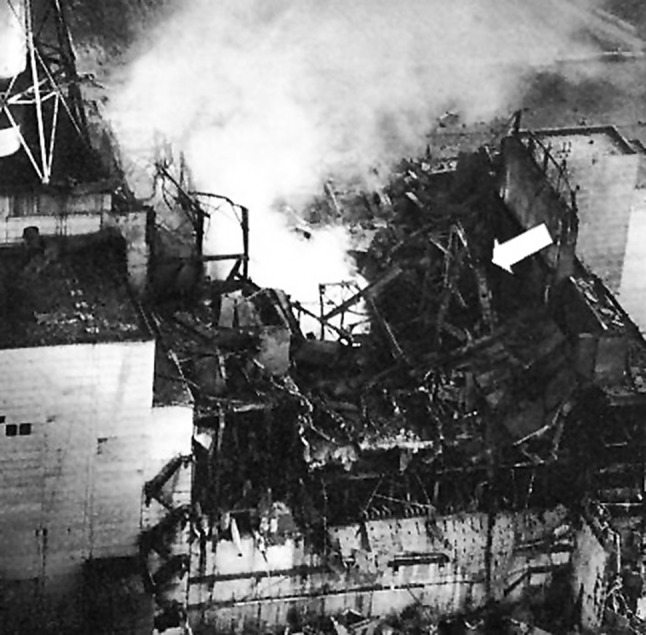
The damaged and burning core region of the Chernobyl-4 reactor in the first days after the accident. The arrow points to the overturned 1000 ton lid of the core cavity. Photo: Unknown Soviet photographer
By the end of November 1986, the damaged reactor had been enclosed in a provisional shelter, providing weather protection and preventing further release of radionuclides off-site. As the provisional shelter shows signs of degradation after more than 25 years, a new safe containment is currently being constructed with an expected service life of more than 100 years, allowing for a successive clean-up of the site.
Releases from the Core and to the Environment
As a consequence of the explosive accident process described above, large parts of the core inventory of radionuclides, especially the gaseous and volatile nuclides, were dispersed into the environment. Thus 100 % of the noble gases, such as Xe-133 were released. About 60 % of core content of I-131 or 1 800 000 Tbq, and about 30 % of core content of Cs-137 or 85 000 TBq were released into the atmosphere (De Cort et al. 1998). A considerable fraction of the release was lifted to high altitudes by the explosive character of the accident.
Root Causes
Root causes to the accident and related deficiencies in safety work include (INSAG 1992):
Serious deficiencies in design, including core stability properties, the performance of the shutdown system and insufficient capacity of the core containment to cope with multiple fuel channel rupture.
Inadequate safety analysis and insufficient attention to independent safety review.
Inadequate and ineffective exchange of important safety information both between RBMK plants and between plants and the designers.
Insufficient understanding and respect on the part of the operators with regard to the safety aspects of operational and test procedures.
A weak regulatory regime that was unable to counter pressures for production.
Taken together, these deficiencies showed that there was a general lack of safety culture in the political and organizational system, at the national level as well as locally (IAEA 1996).
Radiological Impact of the Accident
The large amounts of radioactivity released caused severe ground contamination in the vicinity of the plant. Also, substantial amounts of radioactivity were lifted high up in the atmosphere and transported all over Europe, producing significant local ground contamination depending on wind and precipitation factors (Fig. 10). For example, around 4000 TBq of Cs-137 were deposited on Swedish soil (Moberg and Persson 1996).
Fig. 10.
Cesium deposition on Europe after the Chernobyl accident (De Cort et al. 1998)
Two members of plant staff were killed directly by the explosion. 134 emergency workers were exposed to doses high enough to result in acute radiation syndrome, causing the death of 28 of these workers in 1986. Nineteen more died in 1987–2004 of various causes that may or may not be directly attributable to radiation exposure.
By 2005, close to 7000 thyroid cancers, among them some 15 with lethal outcome, had been diagnosed in population groups exposed to intake of radioactive iodine in the first few months after the accident. Most of the thyroid cancers are probably attributable to the accident. The numbers are expected to increase further.
An international expert group has predicted that among the 600 000 persons receiving more significant exposures, typically above 20 millisievert (the “liquidators” working with the immediate stabilization of the situation at the site and building the shelter, evacuees, and residents of the most contaminated areas), there might be a radiation-induced increase in cancer mortality up to a few percent. This might represent up to about 4000 fatal cancers in addition to the about 100 000 fatal cancers to be expected in this population group, due to all other causes. There are also some indications of an increase in the incidence of leukemia and cataracts among those who received higher doses in this group.
Among the 5 million persons living in areas with exposures in the 10–20 millisievert range, projected increases in cancer mortality are more uncertain but are expected to be less than 1 %. Such increases would be very difficult to detect and attribute to radiation exposure, given the normal variation in cancer mortality rates. Among the several hundred million persons in Europe exposed to doses of a few millisievert or less an increase would be even more difficult to detect. Nevertheless, estimates for Europe have been made using the linear non-threshold (LNT) model for cancer risks related to radiation exposure, Such estimates indicate that, up to 2065, some 25 000 additional cancer cases (other than thyroid) might be attributable to Chernobyl, to be compared with the more than 100 million cases expected from other causes (Cardis et al. 2006). The estimates are presented with large uncertainty bands. In this context, it should be noted that the United Nations Scientific Committee on the Effects of Ionizing Radiation (UNSCEAR) considers it inappropriate to use the LNT model and the collective dose for risk projections, especially when cancer incidence estimates are made for very small additional exposures to very large populations, because the biological and statistical uncertainties are too great.
To conclude, there has been no persuasive evidence up to 2008 of any other health effects than those summarized above that can be attributed to radiation exposure from Chernobyl. Dissenting views have been voiced, but the above summary is based on the joint opinion of a large group of internationally recognized experts in the relevant scientific areas (Chernobyl Forum 2003–2005; UNSCEAR 2008).
Socio-economic and Socio-political Impact
Total costs over the first 25 years since the Chernobyl accident have been estimated to lie in the range 250 000–500 000 million US$. Much of site clean-up, such as removal and safe storage of the damaged core, and other recovery work still remains to be done.
More than 300 000 people in the then Soviet Union were evacuated and relocated from their homes in the most contaminated areas. There was a significant increase in stress-related syndromes in the affected population, where people typically expressed a strong sense of lack of control over their own lives. In fact, many experts regard the mental health impact as the largest public health problem unleashed by the accident (Chernobyl Forum 2003–2005). The most contaminated areas will probably not be fit for normal habitation for up to a hundred years.
Radioactivity in food had to be monitored and controlled over large areas in the then Soviet Union. Around 800 000 ha of agricultural land was removed from service and timber production halted in around 700 000 ha of forest due to high uptake of cesium in the wood.
The response of the natural environment showed a complex interaction between radiation dose and radiosensitivities of different plants and animals (Chernobyl Forum 2003–2005). Numerous adverse effects were observed mainly in high exposure areas within about 30 km from the reactor. Such effects included:
Increased mortality of coniferous plants, soil invertebrates, and mammals;
Reproductive losses in plants and animals;
Genetic effects in both somatic and germ cells in plants as well as animals.
No acute radiation-induced effects have been reported outside the 30 km radius. The affected biotas inside the 30 km radius seem to have recovered to a large extent within a few years after the accident due to reduced exposure levels as radionuclides decayed and migrated.
Across the whole of Europe, radioactive deposits from Chernobyl had to be urgently mapped (see Fig. 10) and appropriate measures taken to monitor and control radioactivity levels in sensitive foods, such as reindeer meat. Media attention and public concern added to the workload of the responsible authorities and government. Due to the large cross-boundary trade of food products in Europe, rapid harmonization of tolerable activity levels in food and associated testing methods became an issue at the highest political level.
Impact on the Nuclear Power Sector
World-wide, the accident triggered expanded cooperation on radiation safety such as:
New international conventions, notably the Convention on Nuclear Safety, under which the contracting parties inter alia committed themselves to a strong and independent national regulatory regime and to mutual peer reviews of their safety work every 3 years.
Revised and upgraded IAEA safety standards and associated voluntary peer reviews.
Creation of the World Association of Nuclear Operators (WANO) to implement the INPO concept of industry-internal peer reviews on a global scale.
Safety culture became a key concept in both IAEA and WANO peer review services.
Fukushima 2011
What Happened?
The Fukushima Daiichi Nuclear Power Station is located on the east coast of Japan, about 250 km to the north of Tokyo. There are six boiling water reactors on the site, all taken into operation during the 1970s. Unit 1 had a rated thermal power output of 1380 MW, units 2–5 2380 MW each, and unit 6 3290 MW. The general design of units 1–5 is shown in Fig. 11. Unit 6 is of a newer design.
Fig. 11.
Schematic of a boiling water reactor (BWR) similar to Fukushima Daiichi unit 1–5. In a BWR, water pumped through the core is brought to boiling, generating steam that feeds the turbine and its attached generator. The steam condensation pool is designed to condense steam released from a postulated pipe break inside the containment to prevent damage from over-pressure. Source: General Electric
At 14:46 on March 11, 2011, a magnitude 9.0 earthquake occurred with an epicenter in the sea about 200 km to the northwest of the Fukushima Daiichi station. At the time of the earthquake, units 1–3 were in normal operation, whereas units 4–6 were shut down, undergoing periodic inspections and refueling. The power production in units 1–3 was immediately stopped as designed as the first vibrations were detected. The subsequent peak accelerations reached 0.56 g in the horizontal direction in some of the units, somewhat higher than the 0.46 g the reactors were designed for. Emergency diesel generators started as designed to provide power to essential cooling and instrumentation systems, as external power was lost due to earthquake damage to transmission lines and switchyards. So far, it has not been possible to establish with certainty whether the earthquake as such caused any damage to reactor systems that may have contributed to some extent to the severity of the accident (NAIIC 2012).
At 15:41 the tsunami generated by the earthquake hit the plant with wave heights that temporarily inundated the station up to about 14 m above sea level (Fig. 12), whereas the reactors were designed to withstand wave heights of 5.7 m. As a result the lower floors of the reactor and turbine buildings were flooded with salt water (Fig. 13), causing failure of the emergency diesels and much other power distribution and instrumentation and control equipment as well as causing other damage. The end result was that cooling of the reactor cores in units 1–3 was lost. In unit 4 the core had been unloaded to the spent fuel pool. In units 5–6, situated on somewhat higher ground than units 1–4, one emergency diesel survived, which was sufficient to maintain cooling of the two reactor cores.
Fig. 12.
The tsunami hits the Fukushima Daiichi Nuclear Power Station on March 11, 2011. Photo: TEPCO
Fig. 13.
Cross-section showing the inundation level at Fukushima Daiichi units 1–4 (NAIIC 2012)
Working literally in the dark with regard to malfunctioning instrumentation and with illumination in the control room and elsewhere reduced to handheld torches, the operators at units 1–4 did heroic efforts to get the situation under control but without success. Over the next few days, the cores in units 1–3 overheated, and probably melted. The melts may in some units have penetrated the bottom of the reactor vessel and molten material ended up on the bottom of the containment (Fig. 14). Large amounts of hydrogen and fission products were released to the containments. The containments developed leaks due to overpressure and other possible mechanisms. Leakage of hydrogen caused violent explosions destroying the upper parts of the reactor buildings in units 1, 3, and 4 (Fig. 15). Substantial amounts of fission products escaped to the environment.
Fig. 14.
Simplified schematic of reactor status after core overheating and partial meltdown, based on theoretical calculations (Weightman et al. 2011)
Fig. 15.
Damage to the reactor buildings of units 3 and 4 caused by hydrogen explosions on March 14–15 (NAIIC 2012). It is assumed that hydrogen from unit 3 leaked into unit 4 via common ventilation ducts. Photo: Air Photo Services, Japan
Only by the end of 2011 had the situation been stabilized at all units with recirculation cooling established of the damaged cores in units 1–3 (Fig. 16) and with temperatures in the reactor pressure vessels and in the containments well below 100 °C. Also, stable cooling of the spent fuel pools in all units had been achieved. Clean-up operations are under way. For example, removal of spent fuel from the spent fuel pool in unit 4 has started. It is estimated that it will take 30–50 years to complete clean-up of the site, not least due to the difficult working conditions in the damaged reactors.
Fig. 16.
Simplified schematic illustrating how the damaged cores of units 1–3 are presently cooled
Releases from the Core and to the Environment
As in TMI, a large part of the fission products were released to the reactor pressure vessels and the containments in units 1–3. Through leaks and other mechanisms, around 150 000 TBq of I-131 and around 12 000 TBq of Cs-137 escaped to the atmosphere. Around 4000 TBq of Cs-137 leaked into the sea in the first months after the accident according to Japanese estimates, although substantially higher amounts have been estimated by French experts (IAEA 2012).
Root Causes
The immediate cause of the accident was of course the damage to the plant and the power grid caused by the combined effect of the earthquake and the subsequent tsunami. But whereas Japanese reactors are designed to survive earthquakes as strong as that which occurred on March 11, 2011, the protection against the subsequent tsunami was totally inadequate. Still, historical records (Fig. 17) show that tsunami waves exceeding a height of 10–20 m have occurred several times in the past few hundred years. Therefore, such waves have to be included in the design basis for the plant according to international safety standards such as those published by the IAEA. Moreover, training, procedures and equipment for management of severe accidents were far from what is considered as good international practices after TMI and Chernobyl. Both the plant owner (TEPCO) and the regulatory authority (NISA) were aware of this situation but neither took appropriate actions, delaying decisions on safety upgrades for various reasons. The Fukushima Nuclear Accident Independent Investigation Commission appointed by the National Diet of Japan (the Japanese Parliament) strongly criticizes the multitude of errors and willful negligence that left the Fukushima plant unprepared for the events of March 11, 2011, and concludes the following: “What must be admitted – very painfully – is that this was a disaster “Made in Japan.” Its fundamental causes are to be found in the ingrained conventions of Japanese culture: our reflexive obedience; our reluctance to question authority; our devotion to ‘sticking with the program’; our groupism; and our insularity.” (NAIIC 2012).
Fig. 17.
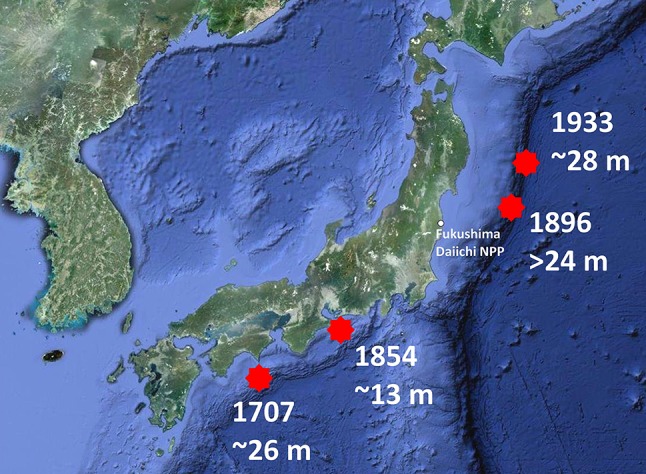
Historical records of tsunami waves exceeding a height of 10–20 m (Weightman et al. 2011). Map: Google Earth
Radiological Impact of the Accident
In combination with rainy weather, the airborne releases of radioactivity caused substantial ground contamination, especially in a plume extending some 40 km to the northwest of the plant (see map in Fig. 18). It is estimated that as much as 1800 km2 of land has contamination levels resulting in a potentially cumulative radiation dose of 5 millisieverts or higher per year (NAIIC 2012). Surveillance and control of radioactivity in various food products can be expected to remain in place for many years to come.
Fig. 18.
Map of accumulated deposits of Cesium-137 as of July 2, 2011 (NAIIC 2012). The red-colored areas correspond to deposits of cesium in excess of 3 MBq/m2; that is, levels that are similar to the levels found around Chernobyl, which, however, cover larger areas
Contrary to Chernobyl, no cases of acute radiation syndrome have so far been reported, but the risk of accidental occupational exposure during clean-up operations on-site will remain. While dealing with the accident, 167 workers were exposed to more than 100 millisieverts. Many more are expected to receive doses up to 100 millisieverts during the continuing clean-up work.
An estimate of the cumulative external exposure over the first 4 months following the accident for approximately 14 000 residents (excluding plant workers) from three towns and villages where radiation doses were relatively high, shows that 0.7 % of the residents have been exposed to 10 millisieverts or more, 42 % have been exposed to less than 10 millisieverts but more than 1 millisievert, and 57 % have been exposed to 1 millisievert or less (NAIIC 2012). Although detailed initial exposure data are lacking, it seems reasonable to assume that residents from less contaminated areas have at most been exposed to similar dose bands (WHO 2012). Future epidemiological studies of the groups concerned over several decades are needed to show if any increases in cancer incidence attributable to the accident can be detected. Given the numbers exposed and the doses received, statistically significant increases are hardly to be expected, except maybe for thyroid cancers in children from the most exposed areas.
As around Chernobyl, the most severe health impact appears to be stress-induced psychosomatic syndromes related to uncertainties about individual doses received, the disruption of family lives and societal fabrics resulting from the evacuation and continuing uncertainty about if and when it will be possible to return to the contaminated areas (NAIIC 2012). Even if the root causes of the stress will remain for many years it appears that the situation could be alleviated to some extent by what could be described as a self empowerment approach. For example, residents returning to less contaminated areas could be provided with knowledge and tools to enable them to evaluate and control their exposure themselves. Such tools would include easily understood information on the health risk associated with small to moderate additional doses, provision of simple radiation monitoring instruments and methods and tools for reducing contamination and exposure. Such approaches are now promoted in Japan (Nomura 2012).
Socio-economic and Socio-political Impact
About 150 000 people have been evacuated from the contaminated zones, mainly within a radius of 20 km from the plant. Evacuation became partly chaotic as evacuation zones were expanded from a 3-km radius to a 20-km radius, all in 1 day. Evacuation of hospitals faced difficulties and it has been estimated that some 60 patients died from complications related to the evacuation (NAIIC 2012). Some limited return has started, but residents in the most contaminated areas will face difficulties in returning for a long time (IAEA 2012).
Before the accident, 54 reactors supplied about 30 % of the electricity in Japan. A number of reactors on the east coast were shut down automatically due to the earthquake. Others were successively shut down as they started their annual refueling and maintenance outage. None were permitted to restart pending safety reviews and local political approval. By the beginning of May 2012 all Japanese power reactors were shut down. By November 2012 only two reactors have been allowed to restart. Restart of more reactors can be expected to take time, partly due to the need for technical safety improvements, partly due to loss of trust in the nuclear industry and government authorities, delaying local political approval.
The loss of nuclear electricity production has been partially offset by stepping up production from fossil-fueled plants but a number of electricity-saving measures have also been necessary. Imports of fossil fuels have increased to the extent significantly affecting the Japanese trade balance, and CO2 emissions have increased. A thorough review of Japan’s long-term energy policy is under way. No political decisions have yet been taken by the new government formed after the parliament elections in December 2012. A reduction in dependence on nuclear power can be expected, compared with the plans envisaged before March, 2011. A total phase-out of nuclear power is among the options considered.
The total costs of the accident in a 50-year perspective are difficult to predict but different cost estimates lie presently in the range of 100 000–500 000 million US$, corresponding to about 2–10 % of Japan’s annual gross domestic product. The Japanese government has been forced to effectively nationalize the utility (TEPCO) that owns the Fukushima plant to enable it to cover the costs of the accident and at the same time continue to provide the Tokyo region with electricity.
International Impact
Internationally, the Fukushima accident has triggered substantial efforts aimed at reassessing and strengthening the safety of nuclear power plants. Thus, the EU as well as other countries has conducted the so-called “stress tests” (European Commission 2012) that include:
Reassessment of plant vulnerabilities with regard to extreme and very unlikely events also affecting several reactors at the same site.
Improved capabilities to cool the core and the spent fuel pools in case of such events.
Strengthening severe accident management capabilities at the plants, including equipment, procedures, and training.
For example, many more countries are now considering implementing similar types of severe accident management and release mitigation systems that Sweden and some other countries installed already in the 1980s (see Fig. 7). Had they been in place at the Fukushima reactors, it is likely that both the on-site and off-site radiological consequences would have been substantially reduced, even if core melts probably could not have been avoided.
Finally, the Fukushima accident has had a profound impact on energy policy in some countries, such as Belgium, Germany, and Switzerland, which are planning to phase-out nuclear power. On the other hand, construction of new reactors continues in many other countries though with some delays due to safety reassessments of the type described above. Thus, by the end of October 2012, 64 new reactors were under construction, the majority of these in China, Russia, India, and the Republic of Korea (IAEA PRIS 2012).
Conclusions
The outcome of the accidents at TMI-2, Chernobyl, and Fukushima shows that severe reactor accidents are not unique in terms of the number of directly attributable fatalities resulting from accidents related to energy production. For example, the Banqiao dam collapse in Hunan, China in 1975 and the 1963 landslide into the Vaiont dam in Italy each caused many thousand fatalities. Also, it has been estimated that with proper off-site emergency response programs, the contribution to individual fatality risk (early and late radiation-induced fatalities) from severe reactor accidents is small compared to other individual health risks, even with releases of Cs-137 in the range of several thousand TBq (U.S. NRC 2012). So far, assessments of the radiological health consequences of Fukushima do not appear to contradict these estimates.
However, severe reactor accidents with radioactive releases in the range of several thousand TBq or more of radionuclides such as Cs-137 may cause unique socio-economic and socio-political consequences due to large-scale and long-lived ground contamination, with associated human and monetary costs, as summarized in Table 2.
Table 2.
Socio-economic impacts of severe accidents in nuclear power reactors
| Accident | Type | Release of Cs-137 (TBq) | Evacuated | Estimated costs million US$ |
|---|---|---|---|---|
| Three Mile Island 1979 | Core melt | ≪1 | Voluntary short-term evacuation of nearby communities due to garbled information | ~6500 |
| Tjernobyl 1986 | Runaway fission process destroying the reactor | 85 000 | >300 000 relocated | 250 000–500 000 |
| Fukushima 2011 | Three cores severely damaged, probably melted | 12 000 | ~150 000 evacuated, prospects to return still unclear after 20 months | 100 000–500 000 |
| Hypothetical severe accident with release mitigation according to present Swedish and Finnish requirements | Core melt | <200 | Precautionary short-term evacuation in the vicinity of the plant? | <20 000? |
Therefore, reactor safety objectives should be based not only on limited contribution to individual health risks but also on limited socio-economic impact. Thus, releases of Cs-137 should be limited to the order of a hundred TBq at most, even if a core melt has occurred. Moreover, it should be possible to achieve a stable end state in the reactor with the damaged core cooled and covered with water in a containment with preserved integrity and at atmospheric pressure. Such an end state would not only reduce risks for radioactive releases substantially but also, as in TMI, facilitate long-term clean-up activities with associated reduction in related costs. Such severe accident management capabilities are achievable in new reactor designs and also in many of the existing reactors by appropriate back-fitting measures. This means that the likelihood of a large release such as at Chernobyl and Fukushima could be substantially reduced even if it cannot be totally eliminated.
Finally, the importance of maintaining high global standards of safety management and safety culture cannot be emphasized enough. All three severe accidents discussed above had their root causes in system deficiencies indicative of poor safety management and poor safety culture in both the nuclear industry and government authorities. Unless there is an effective and perpetual global search for such deficiencies—by industry, by governments, by international organizations—and appropriate actions taken, the likelihood of a future severe accident somewhere in the world cannot be expected to be reduced dramatically compared to the historical experience up to now.
Lars Högberg
was Director General of the Swedish Nuclear Power Inspectorate (SKI) 1989–1999. He has served as a Governor of the IAEA and as Chairman of the Steering Committee of the OECD Nuclear Energy Agency. He has contributed many international reports on nuclear safety, including those of the IAEA International Nuclear Safety Advisory Group (INSAG).
References
- Cardis E, Krewski D, Boniol M, Drozdovitch V, Darby SC, Gilbert ES, Akiba S, Benichou J, Ferlay J, Gandini S, Hill C, Howe G, Kesminiene A, Moser M, Sanchez M, Storm H, Voisin L, Boyle P. Estimates of the cancer burden in Europe from radioactive fallout from the Chernobyl accident. International Journal of Cancer. 2006;119:1224–1235. doi: 10.1002/ijc.22037. [DOI] [PubMed] [Google Scholar]
- Chernobyl Forum 2003–2005. Chernobyl’s legacy: Health, environmental and socio-economic impacts. IAEA, Vienna 2006.
- De Cort, M., Dubois, G., Fridman, Sh.D., Germenchuk, M.G., Izrael, Yu.A., Janssens, A., Jones, A.R., Kelly, G.N., et al. 1998. Atlas of caesium deposition on Europe after the Chernobyl accident. EUR report nr. 16733, EC, Official Publications of the European Communities, Luxembourg.
- European Commission. 2012. Technical Summary on the Implementation of Comprehensive Risk and Safety Assessments of Nuclear Power Plants in the European Union. Document SWD(2012)287, European Commission, Brussels.
- IAEA. 1996. One decade after Chernobyl. In Proceedings of an International Conference in Vienna, 8–12 April 1996, IAEA, Vienna.
- IAEA. 2009. INES: The International Nuclear and Radiological Event Scale. Users Manual (Co-sponsored by the IAEA and OECD/NEA). Vienna: IAEA.
- Fukushima Daiichi Status Report 28 June 2012. Vienna: IAEA; 2012. [Google Scholar]
- IAEA PRIS. 2012. IAEA Power Reactor Information System Data Base. http://www.iaea.org/pris/.
- INSAG. 1986. Summary report on the post-accident review meeting on the Chernobyl Accident. International Nuclear Safety Advisory Group Report INSAG-1. Vienna: IAEA.
- INSAG. 1992. The Chernobyl accident: Updating of INSAG-1. International Nuclear Safety Advisory Group Report INSAG-7. Vienna: IAEA.
- Kemeny, J.G., et al. 1979. Report of the President’s Commission on the Accident at Three Mile Island. New York: Pergamon Press.
- Moberg, L., and Persson, B.Å. 1996. Ten years after the nuclear accident at Chernobyl. Swedish Radiation Protection Institute Report i 96:01 (in Swedish).
- Report to the National Diet of Japan by the Fukushima Nuclear Accident Independent Investigation Commission. Tokyo: The National Diet of Japan; 2012. [Google Scholar]
- Nomura, S. 2012. Lessons learned from the Fukushima Accident. Presentation at the ASME Workshop on Forging a New Nuclear Safety Construct, Washington, DC. http://events.asme.org/NuclearSafetyConstructWorkshop.
- Rasmussen, N.F., et al. 1975. Reactor safety study. An assessment of accident risks in U.S. Commercial Nuclear Power Plants. USAEC Report WASH-1400.
- Reactor Safety Commission. 1979. Safe nuclear power? Swedish Government Official Reports SOU 1979:86 (in Swedish).
- Sandia National Laboratories. 2012. State-of-the-art reactor consequence analyses project: Peach bottom integrated analysis. U.S. NRC Report NUREG/CR-7110, Vol. 1.
- SSI. 1979. More effective emergency preparedness. Report by the Swedish Radiation Protection Institute (SSI) (in Swedish).
- Swedish Government. 1981. Governmental decision 15th October 1981 on conditions for continued operation of the nuclear power reactors at Barsebäck (in Swedish).
- Swedish Government. 1986. Governmental decisions 27th February 1986 on conditions for continued operation of the nuclear power reactors at Forsmark, Oskarshamn and Ringhals (in Swedish).
- The Urban Siting Commission. 1974. Urban siting of nuclear power plants. Swedish Government Official Reports SOU 1974:56 (in Swedish).
- U.S. Atomic Energy Commission. 1957. Theoretical possibilities and consequences of major accidents in large nuclear power plants. USAEC Report WASH-740.
- U.S. NRC. 2009. NRC Backgrounder on the Three Mile Island Accident. U.S. NRC Office of Public Affairs, Washington, DC. http://www.nrc.gov/reading-rm/doc-collections/fact-sheets/3mile-isle.pdf.
- U.S. NRC. 2012. State-of-the-art reactor consequence analysis report. Report NUREG-1935, U.S. NRC, Washington, DC (see also: SOARCA Brochure NUREG/BR-0359).
- UNSCEAR. 2008. Sources and effects of ionizing radiation. Report to the General Assembly with Scientific Annexes, Volume II, Annex D, United Nations, New York, 2011.
- Weightman, M., et al. 2011. Japanese earthquake and tsunami: Implications for the UK nuclear industry, Final Report, HM Chief Inspector of Nuclear Installations, September 2011, ONR Report ONR-FR-REP-11-002, Bootle, Merseyside, UK.
- Preliminary dose estimation from the nuclear accident after the 2011 Great East Japan earthquake and tsunami. Geneva: WHO; 2012. [Google Scholar]



